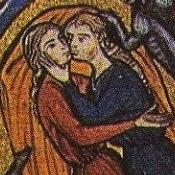Bath Time Again
Wednesday, September 4, 2019 - 07:00
One can pretty much guarantee that any general discussion of women in medieval England is going to talk about Chaucer’s Wife of Bath eventually. This collection gets double-duty from her. It isn't that there aren't other women (and actual, rather than fictitious, women) that appear in texts of the same era. But academia has always been fond of anointing specific figures and stories as central, iconic representations and then building analytic industries around them. In cases (such as women) where the relative volume of documentary material is smaller due to historic marginalization, this contributes to the "tyranny of the single story". The Wife of Bath is an interesting literary character, but she isn't the be-all and end-all of medieval women or even medieval widowhood.
This blog is going to be packed with material for a while because in addition to zipping through the remaining articles in the current singlewomen collection, I've set myself a project to get caught up with my book reviews. And just when all that is sorting itself out, it'll be time to really ramp up in preparation for the release of Floodtide in November. So buckle your seatbelts!
Major category:
Full citation:
Moore, Jeanie Grant. 2003. “(Re)creations of a Single Woman: DIscursive Realms of the Wife of Bath” in The Single Woman in Medieval and Early Modern England: Her Life and Representation, ed. by Laurel Amtower and Dorothea Kehler. Arizona Center for Medieval and Renaissance Studies, Tempe. ISBN 0-06698-306-6
Publication summary:
A collection of articles on the general topic of how single women are represented in history and literature in medieval and early modern England. Not all of the articles are clearly relevant to the LHMP but I have included all the contents.
(Re)creations of a Single Woman
The Wife of Bath gets a lot of exercise as the archetype of the “lusty widow” in Middle English literature. She is the only pilgrim in Chaucer’s Canterbury Tales who is identified by marital status rather than by occupation. (Though ”wife” could also simply mean “woman” at this time.) But she operates, not as a wife, but as an independent singlewoman. Being a widow gives her the freedom to travel that a never-married woman might not have had. She represents an independent woman with agency and power, despite the references in her story to her various husbands. Through speech, she is able to claim the power to define her own history and identity, rather than have it defined for her, as her last husband attempted to do by teaching her woman’s “traditional” place. From one angle, she can be seen as mangling the meaning of the sacred texts she uses to justify her story, but from another angle she can be seen as deliberately re-making them for her own ends. The remainder of the article is a detailed analysis of how the Wife of Bath represents herself within her tale to lay claim to an androgynous and authoritative identity.
Time period:
Place:
Event / person:
View comments (0)
